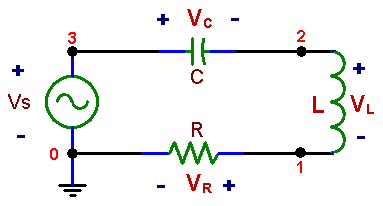EE291- LABORATORY V
AC MEASUREMENTS; AMPLITUDE AND PHASE
OBJECTIVES
Understanding reactance in electrical circuits and measurements of the amplitude and phase differences of two signals using a digital oscilloscope.
PRELAB
1. Calculate current and voltage on all components of the circuit shown below for VS=1V, f = 10 kHz, R = 1 kohms, C = 10 nF and L = 50 mH. It is best to calculate first the current and then the voltage across each element (current * impedance, using complex numbers). Calculate also the phase differences ŠVL - ŠVR and ŠVs - ŠVR
2. What are the phase differences between sinusoidal a.c. voltage and current on a resistor, a capacitor, an inductor, and on a power source supplying a circuit consisting of these three components connected in series (as in Fig. 6, below)?
You may use PSPICE to find the answers.
|
|
|
Fig. 6 Series RLC circuit |
LABORATORY
Equipment needed from the stockroom: Oscilloscope manual, parts kit, proto-board, AVM, leads.
Assemble a circuit consisting of an inductor L, a capacitor C and a resistor R, connected in series, as shown in Fig. 6. The voltage source Vs is a waveform generator supplying a sinewave signal. Select C close to 10 nF, R close to 10 kW and use the 50 mH coil from your parts kit. Measure the values of these components before assembly. The bridge for measurements of L and C is located in front of the stock room counter.
1. Set Frequency
Set the frequency of the generator to about 10 kHz. Particular value of the frequency is not critical, provided that you know what it is. Measure it precisely. Using an AVM, measure voltages across the three circuit elements (R, L, and C) as well as across the voltage source (waveform generator).. Note that you could not do these measurements with an oscilloscope. The voltmeter works here because none of its terminals is grounded. Note also that the relatively low frequency used in these measurements is within the operating range of this instrument. Do the measured voltage values agree with Kirchoff’s voltage law? Explain!
2. Compare Voltages
Compare voltages VS and VR by using two channels of the digital oscilloscope, with probes attached between points 0 - 1 and 0 - 3. Measure amplitudes and the phase difference in degrees (use the digital scope cursors for phase measurements). After measurements at about 10 kHz, repeat for another frequency (for example 5 kHz).
Note that your measurements determine the phase difference between the source voltage VS, and current, which is proportional to VR. (Here the bold letters of voltage symbols indicate complex quantities, which give information on both amplitudes and phases)
3. Measure Phase
Measure the phase difference between the inductor voltage and current. Use two probes: one for voltage proportional to current (points 0 and 1), the other for voltage across both R and L (points 0 and 2). Using a convenient feature of the digital scope you can now subtract the two signals and view simultaneously the voltage across L and across R, and determine their phase difference.
REPORT
-
Present clearly all results. Compare the results of the amplitude and phase measurements in 1. and 2. with calculations for the frequencies and component values used in the lab. Does the Kirchoff’s voltage law apply to AC circuits?
-
Draw a phasor diagram using the measured amplitudes and phases. Check the phasor equation: VS = VC + VR + VL. Comment on the reasons for discrepancy, if there is any.
